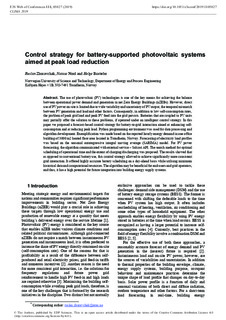| dc.contributor.author | Zhuravchak, Ruslan | |
| dc.contributor.author | Nord, Natasa | |
| dc.contributor.author | Brattebø, Helge | |
| dc.date.accessioned | 2019-09-24T09:26:46Z | |
| dc.date.available | 2019-09-24T09:26:46Z | |
| dc.date.created | 2019-08-24T12:17:25Z | |
| dc.date.issued | 2019 | |
| dc.identifier.citation | E3S Web of Conferences. 2019, 111 . | nb_NO |
| dc.identifier.issn | 2267-1242 | |
| dc.identifier.uri | http://hdl.handle.net/11250/2618421 | |
| dc.description.abstract | The use of photovoltaic (PV) technologies is one of the key means for achieving the balance between operational power demand and generation in net Zero Energy Buildings (nZEBs). However, direct use of PV power on-site is limited due to wide variability and uncertainty of PV output, the temporal mismatch between PV generation and load and other factors. Consequently, in addition to low self-consumption rates, the problem of peak grid load and peak PV feed into the grid persists. Batteries that are coupled to PV units may partially offer the solution to these problems, if operated under an intelligent control strategy. In this paper we proposed a forecast-based control strategy for battery-to-grid interaction aimed at enhancing selfconsumption and at reducing peak load. Python programming environment was used for data processing and algorithm development. Exemplification was made based on the reported hourly energy demand in one office building of 3000 m2 heated floor area located in Trondheim, Norway. Forecasting of electricity load profiles was based on the seasonal autoregressive integral moving average (SARIMA) model. For PV power forecasting, the algorithm communicated with external service – Solcast API. The search method for optimal scheduling of operational time and the extent of charging/discharging was proposed. The results showed that as opposed to conventional battery use, this control strategy allowed to achieve significantly more consistent grid interaction. It offered highly accurate battery scheduling on a day-ahead basis while utilising minimum historical data and computational resources. The algorithm may be beneficial for end-users and grid operators, and thus, it has a high potential for future integration into building energy supply systems. | nb_NO |
| dc.language.iso | eng | nb_NO |
| dc.publisher | EDP Sciences | nb_NO |
| dc.rights | Navngivelse 4.0 Internasjonal | * |
| dc.rights.uri | http://creativecommons.org/licenses/by/4.0/deed.no | * |
| dc.title | Control strategy for battery-supported photovoltaic systems aimed at peak load reduction | nb_NO |
| dc.type | Journal article | nb_NO |
| dc.type | Peer reviewed | nb_NO |
| dc.description.version | publishedVersion | nb_NO |
| dc.source.pagenumber | 8 | nb_NO |
| dc.source.volume | 111 | nb_NO |
| dc.source.journal | E3S Web of Conferences | nb_NO |
| dc.identifier.doi | 10.1051/e3sconf/201911105027 | |
| dc.identifier.cristin | 1718433 | |
| dc.relation.project | Norges forskningsråd: 268248 | nb_NO |
| dc.description.localcode | © The Authors, published by EDP Sciences, 2019. This is an Open Access article distributed under the terms of the Creative Commons Attribution License 4.0, which permits unrestricted use, distribution, and reproduction in any medium, provided the original work is properly cited. | nb_NO |
| cristin.unitcode | 194,64,25,0 | |
| cristin.unitname | Institutt for energi- og prosessteknikk | |
| cristin.ispublished | true | |
| cristin.fulltext | original | |
| cristin.qualitycode | 1 | |

